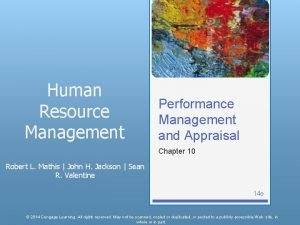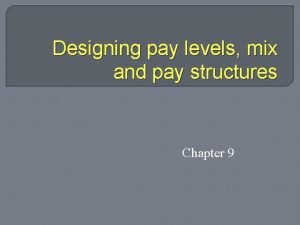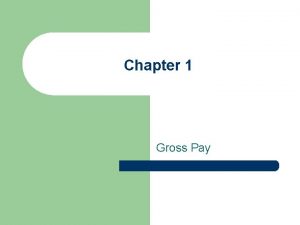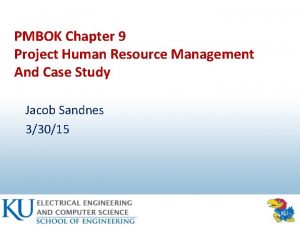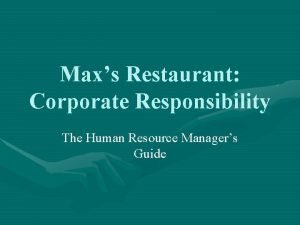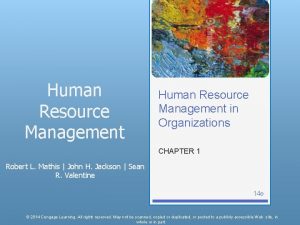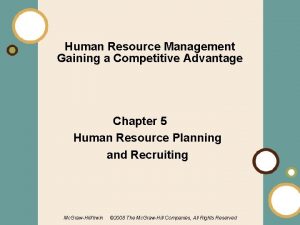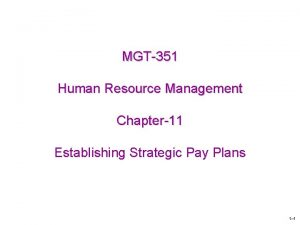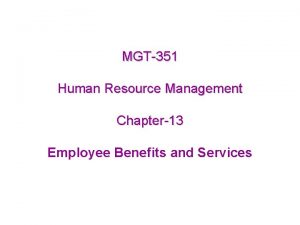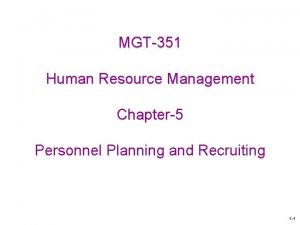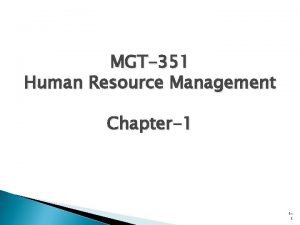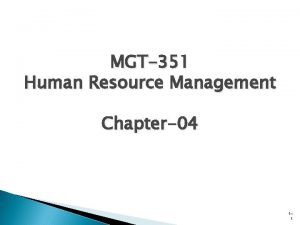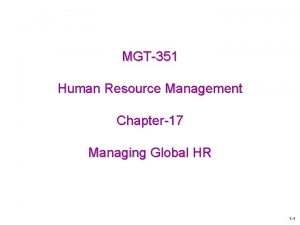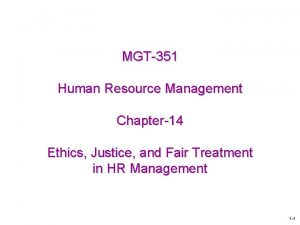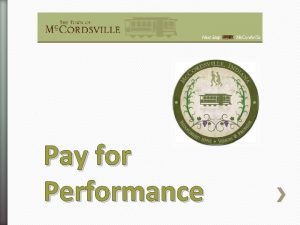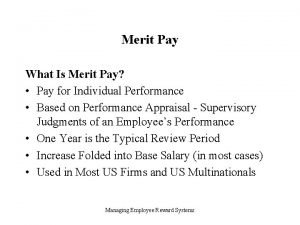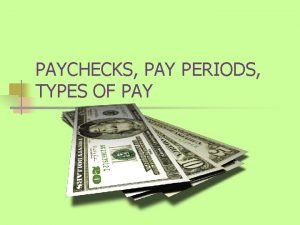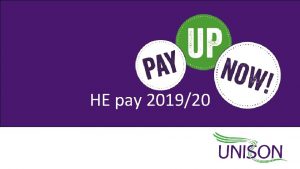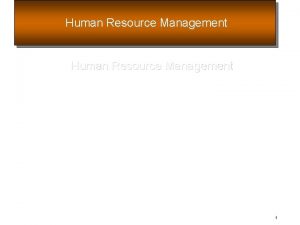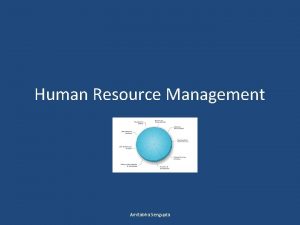MGT351 Human Resource Management Chapter12 Pay for Performance





















- Slides: 21

MGT-351 Human Resource Management Chapter-12 Pay for Performance and Financial Incentives 1– 1

Motivation, Performance, and Pay • Incentives Ø Financial rewards paid to workers whose production exceeds a predetermined standard. • Frederick Taylor Ø Popularized scientific management and the use of financial incentives in the late 1800 s. Ø Fair day’s work: standards for output Ø Scientific management: approach focused on improving work methods through observations and analysis. © 2008 Prentice Hall, Inc. All rights reserved. 12– 2

Individual Incentive Plans • Piecework Plans Ø Type of incentive program whereby the employee is paid based on each unit of output. Employees are paid a certain rate per unit times the number of units produced. v Straight piecework v Guaranteed © 2008 Prentice Hall, Inc. All rights reserved. piecework 12– 3

Piecework Plans • The Straight Piece-Work: Is a system in which the worker is paid according to the number of units produced at a fixed rate per unit during a defined period of time is called a straight piece-work system. • Example: if the piece rate is $1. 25 and the total output is 100 units, then his earnings will be $1. 25 x 100 = $125. • Guaranteed piecework: The minimum hourly wage plus an incentive for each piece produced above a set number of pieces per hour © 2008 Prentice Hall, Inc. All rights reserved. 12– 4

The Straight Piece-Work Step-1: Computing the piece rate: For example, a job has hourly rate $6. 50 per hour. Standard production 40 units per day. Standard hour is 8 hour per day. 40 units 8 hour = 5 units per hour $6. 50 (hourly rate) 5 (units per hour) = $1. 30 per unit Step 2: Computing earnings: So, if the employee produce 40 unit then his/her earnings will be $1. 30 x 40 = $52. © 2008 Prentice Hall, Inc. All rights reserved. 12– 5

Standard hour plan • Standard Hour Plan is a plan by which a worker is paid a basic hourly rate but is paid an extra percentage of his or her rate for production exceeding the standard per hour or per day. It similar to piecework payment but based on a percent premium. • For example, a job has hourly rate $6. 50 per hour. Standard production 40 units per day. Standard hour is 8 hour per day. An employee produced 60 units in a specific day. So his earning for the day will be: 8 X $6. 50 = $52 per day as per standard hour. However, production exceeded 20 units or 50%. so total earning will be = $52 + (50% x $52) = $78 © 2008 Prentice Hall, Inc. All rights reserved. 12– 6

Individual Incentive Plans (cont’d) • Pros and Cons of Piecework Ø Easily understandable, equitable, and powerful incentives Ø Employee resistance to changes in standards or work processes affecting output Ø Quality problems caused by an overriding output focus Ø Possibility of violating minimum wage standards Ø Employee dissatisfaction when incentives either cannot be earned or are withdrawn © 2008 Prentice Hall, Inc. All rights reserved. 12– 7

Individual Incentive Plans (cont’d) • Merit Pay Ø A permanent cumulative salary increase the firm awards to an individual employee based on his or her individual performance. • Merit Pay Options Ø Annual lump-sum merit raises that do not make the raise part of an employee’s base salary. Ø Merit awards tied to both individual and organizational performance. © 2008 Prentice Hall, Inc. All rights reserved. 12– 8

Individual Incentive Plans (cont’d) • Incentives for Professional Employees Ø Professional employees are those work involves the application of learned knowledge to the solution of the employer’s problems. v Lawyers, doctors, economists, and engineers • Possible Incentives Ø Bonuses, stock options and grants, profit sharing Ø Better vacations, more flexible work hours Ø Improved pension plans Ø Equipment for home offices © 2008 Prentice Hall, Inc. All rights reserved. 12– 9

Incentives for Salespeople • Salary Plan Ø Straight salaries v Best for: prospecting (finding new clients), account servicing, training customer’s salesforce, or participating in national and local trade shows. • Commission Plan Ø Pay is a percentage of sales results. v Keeps sales costs proportionate to sales revenues. v May cause a neglect of nonselling duties. v Can create wide variation in salesperson’s income. v Likelihood of sales success may be linked to external factors rather than to salesperson’s performance. v Can increase turnover of salespeople. © 2008 Prentice Hall, Inc. All rights reserved. 12– 10

Incentives for Salespeople (cont’d) • Combination Plan Ø Pay is a combination of salary and commissions, usually with a sizable salary component. Ø Plan gives salespeople a floor (safety net) to their earnings. Ø Salary component covers company-specified service activities. Ø Plans tend to become complicated, and misunderstandings can result. © 2008 Prentice Hall, Inc. All rights reserved. 12– 11

Specialized Combination Plans • Commission-plus-Drawing-Account Plan Ø Commissions are paid but a draw on future earnings helps the salesperson to get through low sales periods. • Commission-plus-Bonus Plan Ø Pay is mostly based on commissions. Ø Small bonuses are paid for directed activities like selling slow-moving items. © 2008 Prentice Hall, Inc. All rights reserved. 12– 12

Team/Group Incentive Plans • Team (or Group) Incentive Plans Ø Incentives are based on team’s performance. • How to Design Team Incentives Ø Set individual work standards. Ø Set work standards for each team member and then calculate each member’s output. Ø Members are paid based on one of three formulas: v All receive the same pay earned by the highest producer. v All receive the same pay earned by the lowest producer. v All receive the same pay equal to the average pay earned by the group. © 2008 Prentice Hall, Inc. All rights reserved. 12– 13

Team/Group Incentive Plans (cont’d) • Pros Ø Reinforces team planning and problem solving Ø Helps ensure collaboration Ø Encourages a sense of cooperation Ø Encourages rapid training of new members • Cons Ø Pay is not proportionate to an individual’s effort Ø Rewards “free riders” © 2008 Prentice Hall, Inc. All rights reserved. 12– 14

Organizationwide Incentive Plans • Profit-Sharing Plans Ø Cash plans v Employees receive cash shares of the firm’s profits at regular intervals. Ø The Lincoln incentive system v Profits are distributed to employees based on their individual merit rating. Ø Deferred profit-sharing plans v. A predetermined portion of profits is placed in each employee’s account under a trustee’s supervision. © 2008 Prentice Hall, Inc. All rights reserved. 12– 15

Organizationwide Incentive Plans (cont’d) • Employee Stock Ownership Plan (ESOP) Ø A firm annually contributes its own stock—or cash (with a limit of 15% of compensation) to be used to purchase the stock—to a trust established for the employees. Ø The trust holds the stock in individual employee accounts and distributes it to employees upon separation from the firm if the employee has worked long enough to earn ownership of the stock. © 2008 Prentice Hall, Inc. All rights reserved. 12– 16

Advantages of ESOPs • The Company Ø Can take a tax deduction equal to the fair market value of the shares transferred to the ESOP trustee. Ø Gets an income tax deduction for dividends paid on ESOP-owned stock. Ø Can borrow against ESOP in trust and then repay the loan in pretax rather than after-tax dollars. © 2008 Prentice Hall, Inc. All rights reserved. 12– 17

Advantages of ESOPs (cont’d) • Employees Ø Develop a sense of ownership in and commitment to the firm. Ø Do not pay taxes on ESOP earnings until they receive a distribution. • Shareholders of Closely-Held Corporations Ø Can place assets into an ESOP trust which will allow them to purchase other marketable securities to diversify their holdings. © 2008 Prentice Hall, Inc. All rights reserved. 12– 18

Implementing a Gainsharing Plan 1. Establish general plan objectives. 2. Choose specific performance measures. 3. Decide on a funding formula. 4. Decide on a method for dividing and distributing the employees’ share of the gains. 5. Choose the form of payment. 6. Decide how often to pay bonuses. 7. Develop the involvement system. 8. Implement the plan. © 2008 Prentice Hall, Inc. All rights reserved. 12– 19

Incentives for Managers and Executives • Short-Term Incentives: The Annual Bonus Ø Plans that are designed to motivate short-term performance of managers and are tied to company profitability. • Issues in Awarding Bonuses Ø Eligibility basis Ø Fund size basis Ø Individual awards © 2008 Prentice Hall, Inc. All rights reserved. 12– 20

Incentives for Managers and Executives (cont’d) • Long-Term Incentives Ø Cash Ø Stock options Ø Restricted stock plans Ø Golden parachutes Ø Guaranteed loans © 2008 Prentice Hall, Inc. All rights reserved. 12– 21
 Performance appraisal in human resource management
Performance appraisal in human resource management Management fifteenth edition
Management fifteenth edition Time management human resources
Time management human resources Human resource management in retail management
Human resource management in retail management Role of personnel management
Role of personnel management How much did wanda pay in taxes this pay period
How much did wanda pay in taxes this pay period Designing pay levels
Designing pay levels Short term incentive
Short term incentive Graduated commission examples
Graduated commission examples Project human resource management pmbok ppt
Project human resource management pmbok ppt Project human resource management pmbok
Project human resource management pmbok Resource management importance
Resource management importance Human resource management in restaurants
Human resource management in restaurants Human induction meaning
Human induction meaning Chapter 2 human resource management
Chapter 2 human resource management Chapter 9 human resource management
Chapter 9 human resource management Hrms shanker group
Hrms shanker group Current issues in human resource management
Current issues in human resource management Ba human resource management
Ba human resource management Employer employee relationship in hrm
Employer employee relationship in hrm Human resource management gaining a competitive advantage
Human resource management gaining a competitive advantage Human resource management gaining a competitive advantage
Human resource management gaining a competitive advantage
